Steel Markets

North American Auto Assemblies Improve in October
Written by David Schollaert
November 8, 2021
North American auto assemblies recovered in October after reaching the lowest monthly total year-to-date in September. October’s production total jumped 18.1% sequentially but was still down 24.6% year on year.
The impact of the chip shortage and supply-chain disruptions is still constraining the automotive sector. Semiconductor scarcity and parts delays had further worsened through the third quarter, reducing vehicle inventories and causing regional sales to tumble during the month, according to LMC Automotive (LMCA).
North American vehicle production, including personal and commercial vehicles, totaled 1.073 million units in October, down from 1.424 million units in October 2020, the most recent peak.
Despite some improvements, and speculation that the worst may have passed, continued delays and production shortages are expected at vehicle assembly plants across the country for the remainder of the year. The duration of the chip shortage is still expected to carry on well into 2022, keeping vehicle inventories at historically low levels and further impacting sales.
Sales volumes saw an aggressive rebound a year ago, recovering from the initial impact of the COVID-related closures. The extended effects of the pandemic caused U.S. light vehicle sales to tumble further last month, partly due to the lack of inventory. Volumes fell by 22.6% year on year to just 1.05 million units in October. The annualized selling rate, nonetheless, increased to 13.1 million units per year compared with 12.1 million the month prior.
The chip shortage – and supply chain disruptions more generally – continued to weigh on inventory and therefore sales. The average transaction prices hit another record high of $44,417, or 99.4% of MSRP, and incentives slipped to just $1,598, with Honda, LandRover, Subaru, and Toyota not even reaching $1,000, said the LMCA.
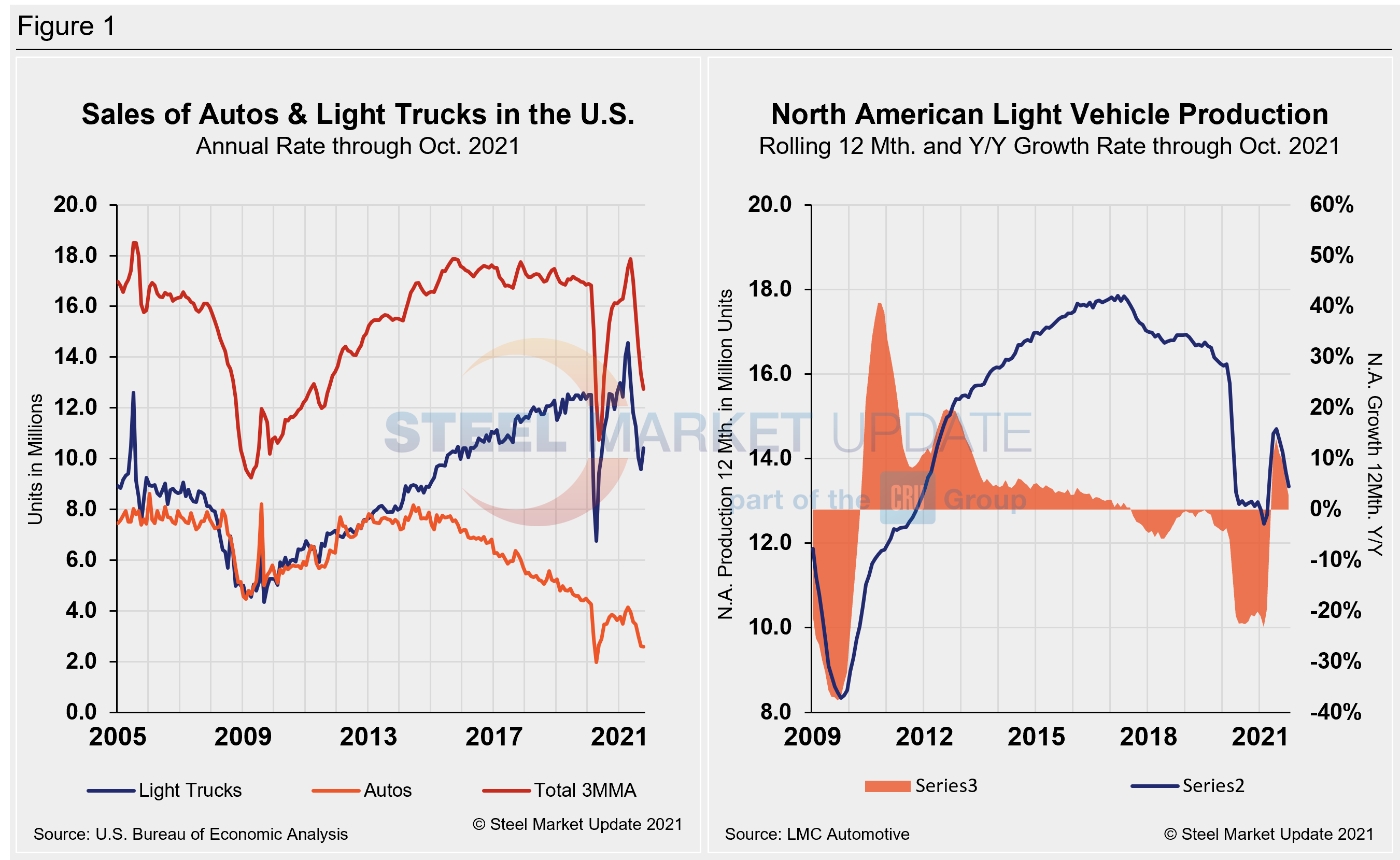
A short-term snapshot of assembly by nation and vehicle type is shown in the table below. It breaks down total North American personal and commercial vehicle production into the U.S, Canadian and Mexican components, along with the three- and 12-month growth rate for each. At the far right it shows the momentum for the total and for each of the three nations.
Although the initial rebound from the COVID-19 doldrums was impressive, the effect of the chip shortage has been even more damaging due to its prolonged nature. Through June, growth rates for personal and commercial light vehicles soared by 156.8% and 127.4%, respectively, but have since seen a nosedive as the chip shortage and supply-chain disruptions have taken hold.
In three months through October, the growth rate for total personal vehicle assemblies in the USMCA was a negative -30.1% year over year, while commercial light vehicle assemblies saw a decline of -14.0% over the same period. The impact of the global semiconductor chip shortage on automotive production across North America has been disastrous.
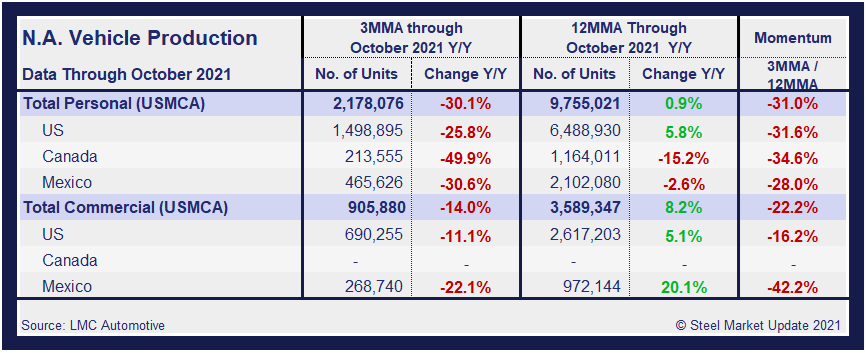
Personal Vehicle Production
The longer-term picture on personal vehicle production across North America is shown below. The first chart in Figure 2 shows the total personal vehicle production for North America and the total for each nation. The production of personal vehicles in the U.S. and the year-over-year growth rate is displayed in the second chart. Figure 3 shows side-by-side the production of personal vehicles in Canada and Mexico and the year-over-year growth rate.
In terms of personal vehicle production, all three countries in the region saw a recovery in October. Canada saw the greatest percentage increase at 22.9% or 13,039 units when compared to the month prior. The U.S. saw the largest growth in total units, up 65,022 units or 14.6% month on month. Mexican auto assemblies were up 9.0% or 12,816 units in October versus the prior month. The annual growth rate across the region plummeted–Canada saw the most aggressive decrease at -49.9%, followed by Mexico at -30.6% and the U.S. at -25.8%.
Canada’s personal vehicle production share of the North American market slipped to 9.8% in October, compared to 10.5% the month prior. Mexico was 21.4% last month versus 22.2% in September, while the U.S. edged up to a 68.8% share of the North American market in October versus 67.4% the month prior.
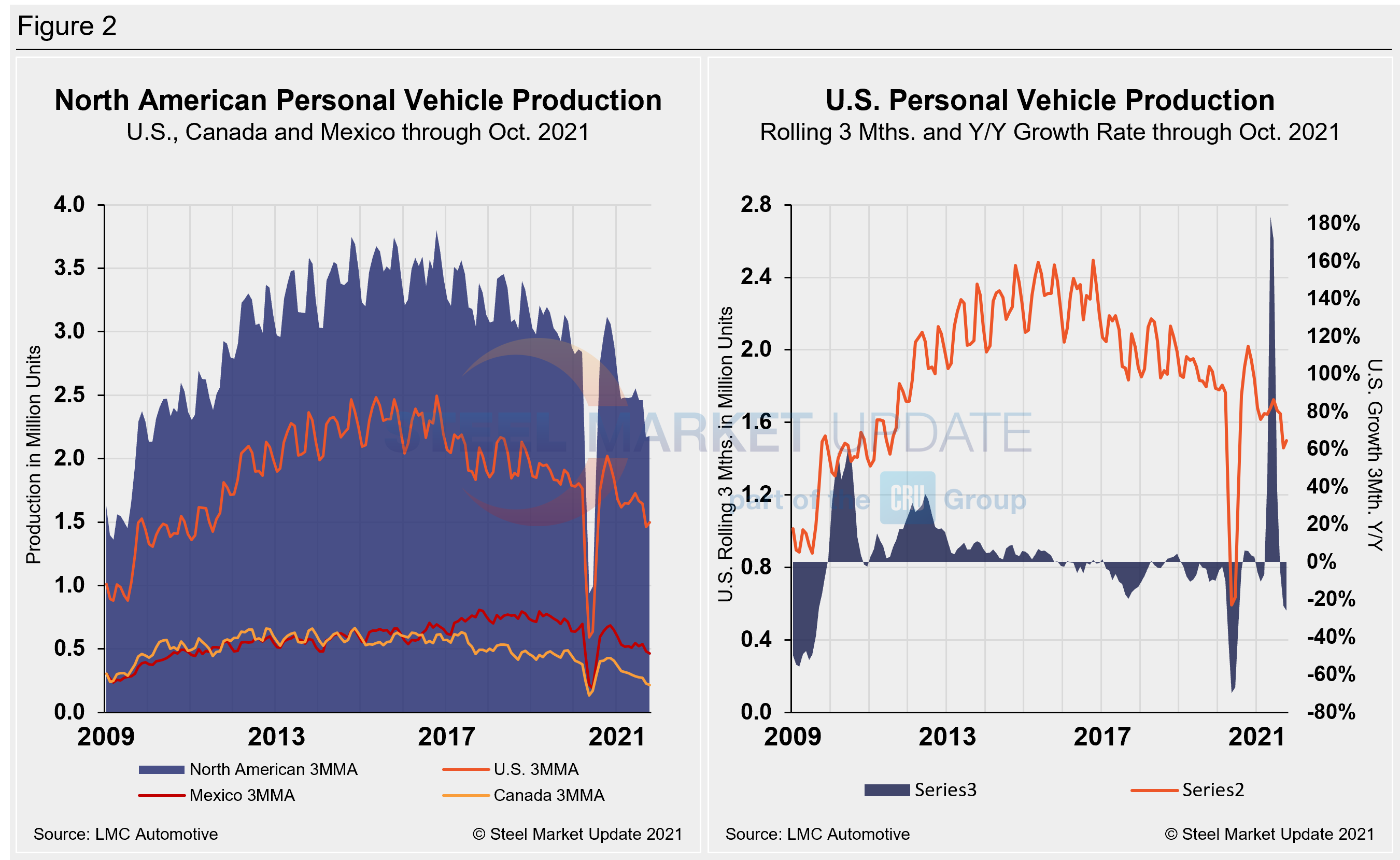
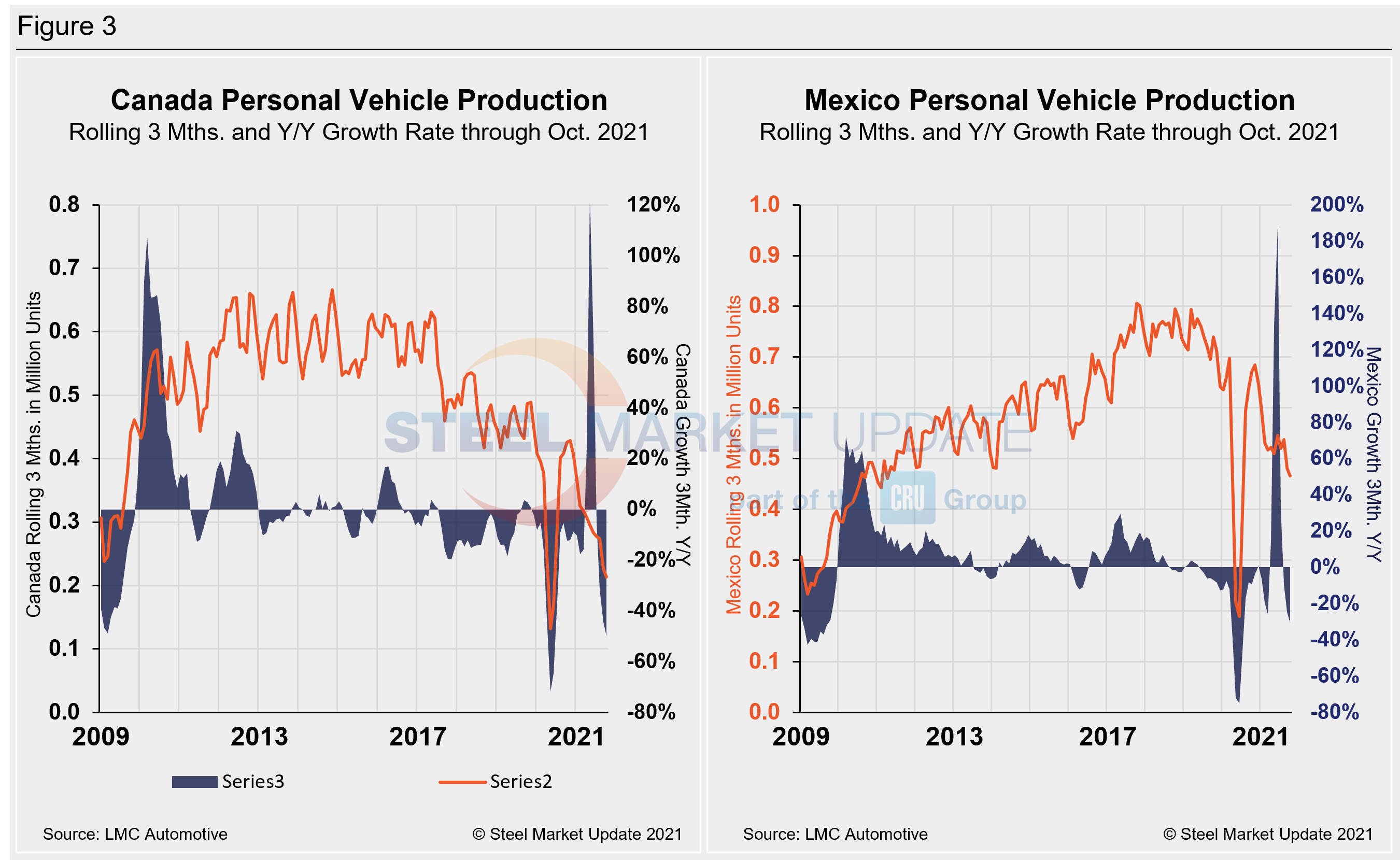
Commercial Vehicle Production
Total commercial vehicle production for North America and the total for each nation on a rolling three-month basis is shown below in the first chart in Figure 4, while the production of commercial vehicles in the U.S and the year-over-year growth rate is displayed in the second chart. Figure 5 shows the production of commercial vehicles and the year-over-year growth rate in Mexico displayed in the first chart, while the second chart shows the production share for each nation. Note that Canada has not produced any commercial vehicles over the past 22 consecutive months.
North American commercial vehicle production was up 28.1% in October, an increase of nearly 74,000 units compared to the prior month. The month-on-month boost was driven by a 30.9% jump in the U.S., an addition of 61,417 units in October. Mexican production of light commercial vehicles rose from September to October by 12,421 units or 19.5%. Production limitations due to the semiconductor shortage and other supply-chain constraints are expected to continue through the fourth quarter, but the recovery was a welcome sign to the automotive lines.
The annual growth rate is now negative at -22.1% in Mexico, year on year, while the U.S. growth rate over the same period is -14.0%. The U.S. share was 77.4% in October, up 1.2 percentage points when compared to the month prior. Mexico’s share fell by the same rate month on month to 22.6%. Presently, Mexico exports just under 80% of its light vehicle production, while the U.S and Canada are the highest volume destinations for Mexican exports.
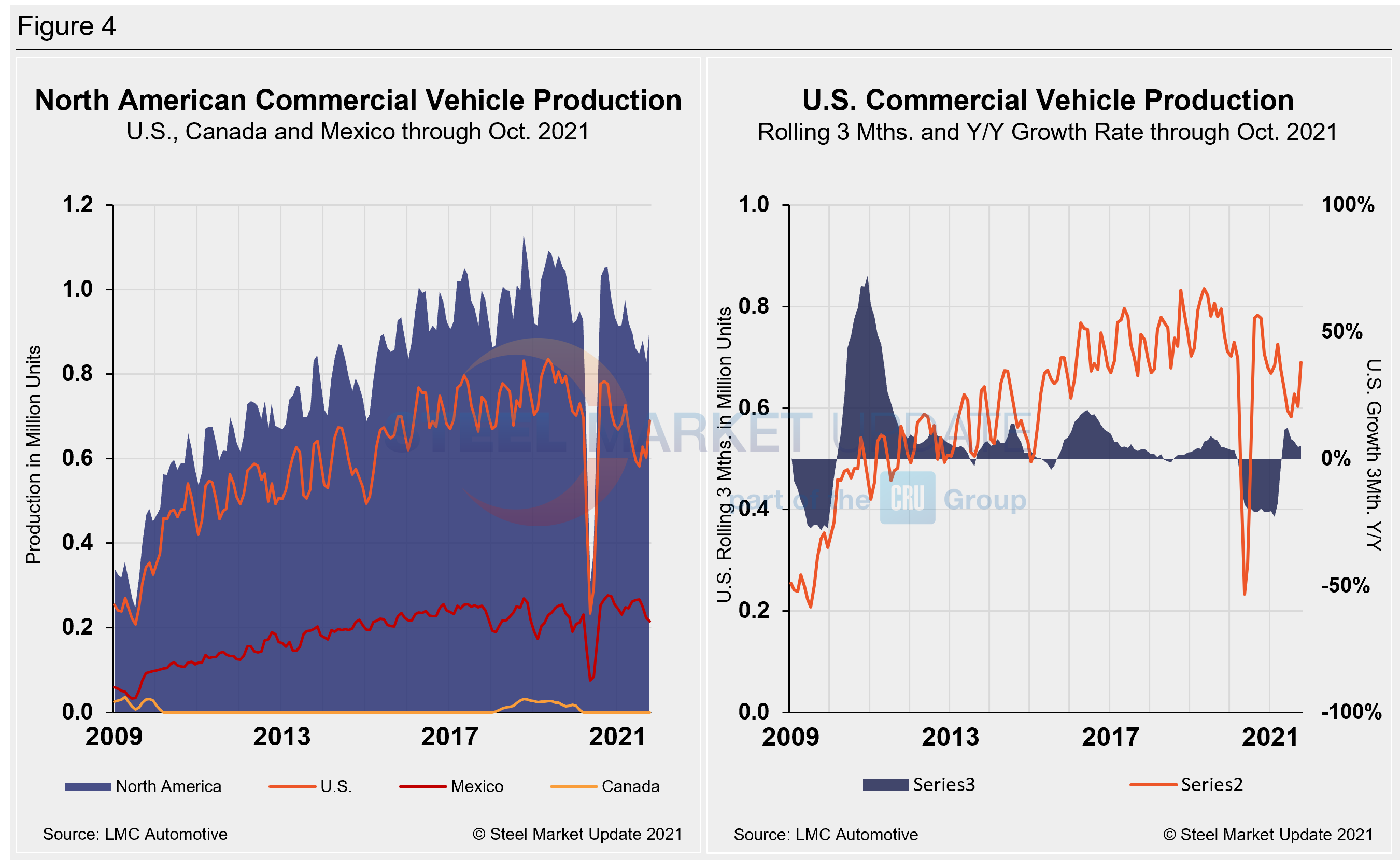
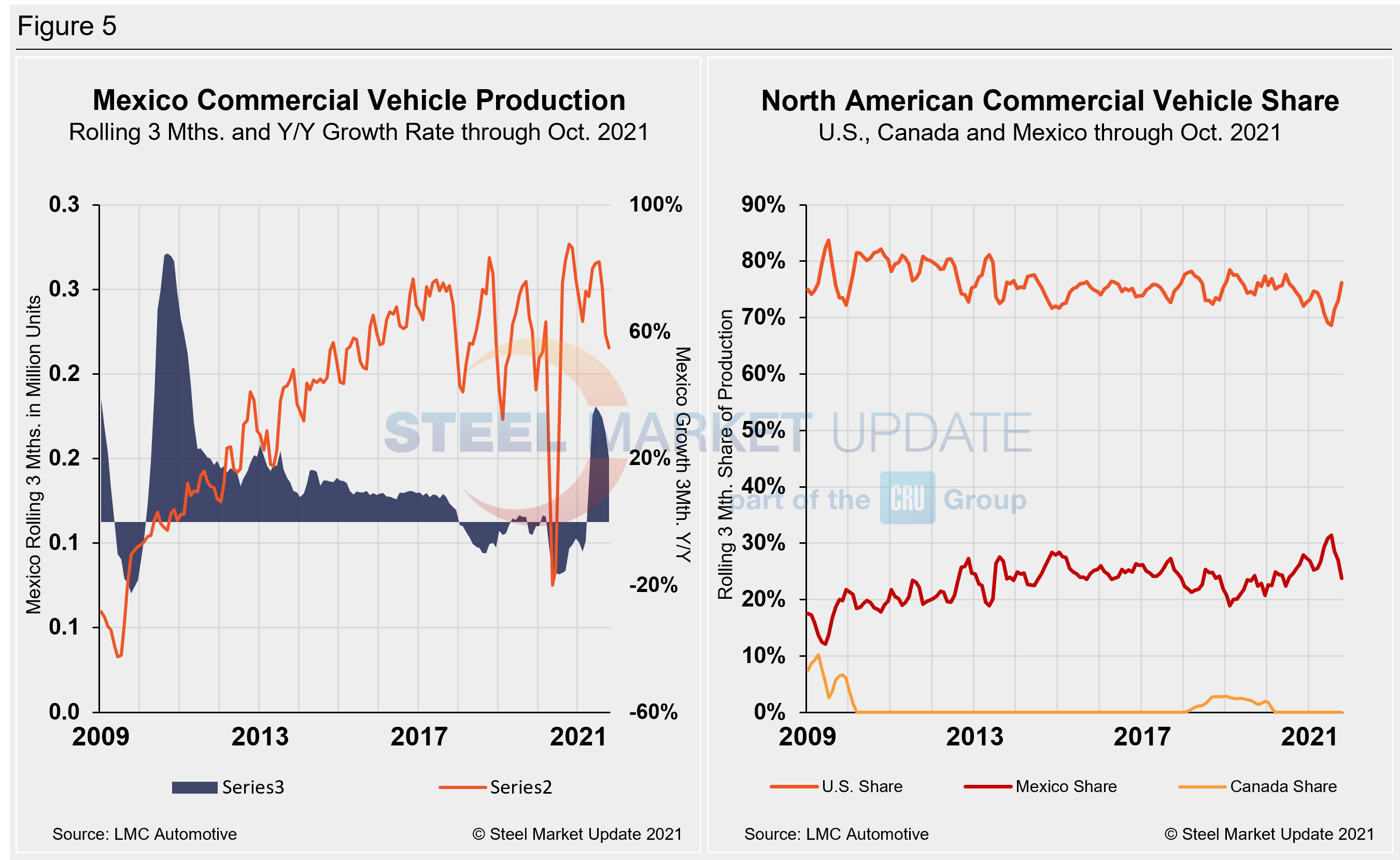
Editor’s Note: This report is based on data from LMC Automotive for automotive assemblies in the U.S., Canada and Mexico. The breakdown of assemblies is “Personal” (cars for personal use) and “Commercial” (light vehicles less than 6.0 metric tons gross vehicle weight rating; heavy trucks and buses are not included). In this report, we describe light vehicle sales in the U.S. and report in detail on assemblies in the three regions of North America.
By David Schollaert, David@SteelMarketUpdate.com

David Schollaert
Read more from David SchollaertLatest in Steel Markets

USW cheers Evraz NA agreement with Atlas Holdings
The United Steelworkers (USW) labor union celebrated recent news of the signed agreement between Atlas Holdings and Evraz NA in which the Connecticut-based private equity company said it plans to acquire North America’s Evraz facilities.

Steel buyer spirits tempered by soft spot market conditions
Steel sheet buyers report feeling bogged down by the ongoing stresses of stagnant demand, news fatigue, tariff negotiations or implementation timelines, and persistent macroeconomic uncertainty.

Hot-rolled coil buyers continue seeking certainty
Steel market participants contend that buyers will remain in “wait-and-see" mode until some market stability is restored.

Latin American steel advocates warn on cheap import flood
Subsidized Chinese steel imports and cheap steel products from Association of Southeast Asian Nations (ASEAN) entering Latin American (LATAM) are threatening the region's steel market.

CRU: Steel prices fall amid global demand weakness
The forceful headwinds bearing down on steel markets across the globe have created demand challenges and sent prices southward. The US, however, challenged the global trend.
